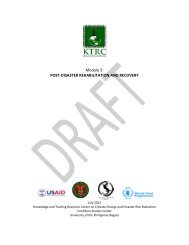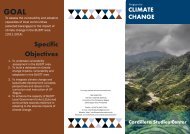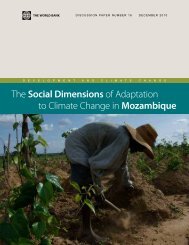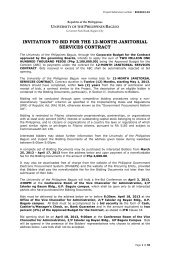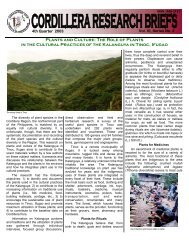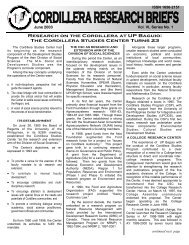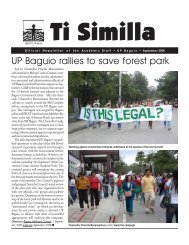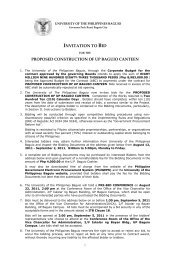Ghana - UNEP
Ghana - UNEP
Ghana - UNEP
- No tags were found...
Create successful ePaper yourself
Turn your PDF publications into a flip-book with our unique Google optimized e-Paper software.
ASSESSING POLICY OPTIONS FOR INCREASINGTHE USE OF RENEWABLE ENERGY FORSUSTAINABLE DEVELOPMENT:MODELLING ENERGY SCENARIOS FOR GHANAA UN-ENERGY Demonstration Studyconducted byDepartment of Economic and Social Affairs (DESA)Food and Agriculture Organization (FAO)International Atomic Energy Agency (IAEA)United Nations Environment Programme (<strong>UNEP</strong>)United Nations Industrial Development Organization (UNIDO)to be presented atCSD-141-12 May 2006UN Headquarters, New York, NY, USA
PrefaceUN-Energy was created in 2004 as the United Nations’ principal interagency mechanism in the fieldof energy. Its creation responds to a request in the Johannesburg Plan of Implementation, adopted bythe 2002 World Summit on Sustainable Development, for a new collaborative mechanism betweenUN agencies, programmes and institutions.UN-Energy has now grown to 20 members and published two reports: “The Energy Challenge forAchieving the Millennium Development Goals” for the September 2005 World Summit in New Yorkand “Energy in the United Nations: An Overview of UN Energy Activities” for the May 2006fourteenth session of the UN Commission on Sustainable Development (CSD-14).This report is the third to be published by UN-Energy. It breaks new ground in being the first topresent analytic results from interagency cooperation that, without UN-Energy, would simply not havehappened. The study was carried out by five UN organizations and the Energy Commission of <strong>Ghana</strong>.It was led by the International Atomic Energy Agency (IAEA) and included the Department ofEconomic and Social Affairs (DESA), the Food and Agriculture Organization (FAO), the UNEnvironment Programme (<strong>UNEP</strong>) and the UN Industrial Development Organization (UNIDO).The study analyzes alternative national policies to increase the share of renewables in the energysupply mix of <strong>Ghana</strong>. It was initiated by DESA in response to the Johannesburg Plan ofImplementation’s call to, “With a sense of urgency, substantially increase the global share ofrenewable energy sources”. The study combines the IAEA models for analyzing national energysystems with data provided by the Energy Commission of <strong>Ghana</strong>, <strong>UNEP</strong>, FAO and UNIDO. It is ademonstration study, not a comprehensive analysis of policy options for <strong>Ghana</strong>. But it providesgeneric insights on policy options and describes one sort of joint assistance that UN organizations canoffer to interested States.A second such study is already underway for Sichuan province in China, and I look forward to UN-Energy serving as a continuing catalyst for new similar cooperation among UN organizations in theservice of our Member States.Mats KarlssonChair, UN-EnergyMay, 2006
Table of ContentsSUMMARY………………………………………………………………………………………………………..i1 INTRODUCTION........................................................................................................................................ 12 PREVAILING ECONOMIC AND ENERGY SITUATION IN GHANA............................................... 13 MAIN ENERGY INSTITUTIONS............................................................................................................. 24 KEY ENERGY ISSUES IN GHANA ......................................................................................................... 34.1 ACCESSIBILITY AND AVAILABILITY OF MODERN ENERGY....................................................................... 34.2 AFFORDABILITY ..................................................................................................................................... 34.3 IMPORT DEPENDENCE ............................................................................................................................. 35 DEVELOPMENT OF FUTURE ENERGY SCENARIOS....................................................................... 45.1 METHODOLOGICAL APPROACH............................................................................................................... 45.2 MAIN ASSUMPTIONS .............................................................................................................................. 45.2.1 Demographic development................................................................................................................ 45.2.2 Economic growth targets .................................................................................................................. 55.2.3 Future potential for development of indigenous energy resources ................................................... 75.2.4 Energy import options....................................................................................................................... 95.2.5 Power generation system ................................................................................................................ 125.2.6 Fuel price assumptions.................................................................................................................... 126 SCENARIO RESULTS.............................................................................................................................. 136.1 FUTURE ENERGY DEMAND.................................................................................................................... 136.2 PRIMARY ENERGY SUPPLY.................................................................................................................... 136.3 POLICIES AND MEASURES TO PROMOTE RENEWABLE ENERGY SOURCES ............................................... 157 ENERGY ISSUES REVISITED ............................................................................................................... 197.1 ACCESSIBILITY AND AVAILABILITY...................................................................................................... 197.2 AFFORDABILITY ................................................................................................................................... 207.3 IMPORT DEPENDENCE ........................................................................................................................... 208 CONCLUDING REMARKS..................................................................................................................... 219 FOR READERS INTERESTED IN UNDERTAKING SIMILAR STUDIES WITH UN SUPPORT 229.1 ENERGY RESOURCE DATA AND INFORMATION ON DESA, FAO, <strong>UNEP</strong>, UNIDO AND UN-ENERGY .... 229.2 IAEA ENERGY MODELS........................................................................................................................ 22REFERENCES 23APPENDIX: The MAED and MESSAGE Models 24
ASSESSING POLICY OPTIONS FOR INCREASING THE USE OFRENEWABLE ENERGY 1 FOR SUSTAINABLE DEVELOPMENT:MODELLING ENERGY SCENARIOS FOR GHANA1 IntroductionThe World Summit on Sustainable Development (WSSD) requested in its Johannesburg Plan ofImplementation that a new collaborative mechanism between United Nations agencies, programmesand institutions be formed. In response, UN-Energy was created in 2004 as the principal interagencycoordinating mechanism in the field of energy within the UN system. Its purpose is to help ensurecoherence in the UN system’s multi-disciplinary response to WSSD and to collectively engage non-UN stakeholders.One of the joint activities agreed by UN-Energy is directly related to a major energy-related objectiveof WSSD, namely, “increasing the proportion of energy obtained from renewable energy sources”. Inthis regard, UN-Energy agreed to conduct two case studies, <strong>Ghana</strong> and Sichuan Province in China.These case studies are designed to assess policy options that could be instrumental in fostering greateruse of renewable energy, their effectiveness and their costs.<strong>Ghana</strong> is particularly suitable for such a study. While its fossil fuel resources are very limited it hasreasonable resources of renewable energy: biomass, wind, solar and micro hydro. These renewableresources could help to increase the available energy supply, reduce the country’s energy import billand enhance security of energy supply.The IAEA’s energy-environment planning and analysis tools were used for this case study to test theefficacy of various policy options in the context of a comprehensive national energy system. Thespecific tools used include MAED (Model for Analysis of Energy Demand) and MESSAGE (Model ofEnergy Supply Systems and their General Environmental Impacts). While the case studies have beenled by the IAEA, other UN-Energy members – DESA, <strong>UNEP</strong>, FAO, UNIDO and the World Bank –have contributed input and assistance in their areas of expertise. The Government of <strong>Ghana</strong>contributed in a major way to the success for the study.2 Prevailing Economic and Energy Situation in <strong>Ghana</strong>Energy is an essential input for economic growth, and per capita use of energy is considered to be akey indicator of economic development. The <strong>Ghana</strong>ian economy grew at an average annual rate of4.7% during the period 1984-94, and 4.4% during the period 1994-2004 (World Bank, 2005a). Despitethis respectable growth compared to many sub-Saharan African countries, the per capita GrossDomestic Product (GDP) for the some 20 million inhabitants was only US$369 in the year 2004,which in terms of purchasing power parity (GDP ppp /capita) was US$2,315 (World Bank, 2005b). Totalenergy use 2 in <strong>Ghana</strong> is 237 petajoule (PJ) which is equivalent to 12 gigajoule (GJ) per capita. Thelevel of per capita commercial energy use is 4.5 GJ, which is less than one tenth of the world average.The energy balance of <strong>Ghana</strong> for the year 2003 is listed in Table 1. (The year 2003 has been selectedas the base year for the study for reasons of data availability.) In terms of energy demand, thehousehold sector is the largest consumer of energy, followed by transport and industry.As for energy supply, only one-third of <strong>Ghana</strong>’s total energy supply is in the form of commercialenergy, while the rest is traditional fuels which are low efficiency and mainly burned for cooking. Inthis report “traditional fuels” refers to wood, charcoal, crop residues and animal residues – which theconsumer either pays for (charcoal, wood) or collects free of cost (crop residues, animal residues,branches of trees, etc.).1 In this report “renewable” includes wind, solar (thermal and photovoltaic), micro hydro and bio energy(traditional – fuelwood and modern - bio-diesel)2 Commercial and non-commercial (traditional biomass) energy1
Out of total primary energy supply of 343.3 PJ in the year 2003, about one-third was imported. Theseimports included some 87% of commercial energy supplies, in the form of crude oil, petroleumproducts and electricity. The entire demand for oil and petroleum products was met through imports.Table 1: Energy balance of <strong>Ghana</strong> in 2003 (PJ)Crude Oil Hydro Biomass aOilProducts Charcoal Electricity TotalProduction 0.0 14.0 233.1 0.0 0.0 0.0 247.1Imports 76.7 0.0 0.0 31.1 0.0 3.7 111.5Exports 0.0 0.0 0.0 -13.2 0.0 -2.2Total Primary Supply 76.7 14.0 233.1 17.9 0.0 1.5 343.3Petroleum Refineries -57.0 0.0 0.0 54.5 0.0 0.0Electricity Plants -19.7 -14.0 0.0 -0.1 0.0 21.4Charcoal Production 0.0 0.0 -127.8 0.0 39.6 0.0T&D Losses b 0.0 0.0 0.0 0.0 0.0 -3.1Total Transformation -76.7 -14.0 -127.8 54.4 39.6 18.2Total Final Energy 0.0 0.0 105.3 72.3 39.6 19.7 237.0Households 0.0 0.0 73.9 5.5 36.5 10.1 126.0Commercial & Services 0.0 0.0 0.8 0.2 3.1 2.0 6.0Agriculture & Fisheries 0.0 0.0 0.2 5.4 0.0 0.0 5.6Industry 0.0 0.0 30.6 5.7 0.0 7.6 44.0Transport 0.0 0.0 0.0 55.5 0.0 0.0 55.5a Includes firewood, crop residues and animal residues. In the rest of the report, biomass includes charcoal also.b Transmission and distribution losses.The total installed electricity generation capacity of the country in 2003 was 1,903 MW of which1,198 MW is hydropower. Actual generation was some 5,900 GWh, reflecting an averageavailability/capacity factor of about 35%. About 65% of all generation was from hydropower plants.Table 2 shows the generating plants in <strong>Ghana</strong> and their characteristics.Name ofplantTable 2: Power sector in <strong>Ghana</strong> (2003)FuelInstalledcapacity(MW)Dependablecapacity(MW)ElectricityGeneration in 2003(GWh)Akosombo Hydro 1,038 850 3,210Kpong Hydro 160 120 675Tapco Light crude oil a 330 330 1,328Tico Light crude oil a 220 220 668Tema Diesel 30 20 19Barge Natural gas b 125 0Total 1,903 1,540 5,900aWill convert to natural gas when available.b This barge mounted power plant is not operational. It was built to use natural gas from the thendrilled off-shore Tano field. However, an adequate quantity of gas was not discovered. The plantwill start when imported gas is available in 2007.Source: World Bank, 2005c.3 Main Energy InstitutionsThe energy system in <strong>Ghana</strong> is essentially managed by the public sector. The Ministry of Energy isresponsible for formulating and implementing energy and electricity policies. The Energy Commissionadvises the Government on energy policy and strategy. The Commission is also involved in indicativeplanning of energy and electricity system expansion, and licensing of energy sector operators. ThePublic Utilities Regulatory Commission (PURC) is a prime body for setting tariffs and framingcustomer service regulations.2
The Volta River Authority (VRA), a state owned entity, is responsible for electricity generation andtransmission in <strong>Ghana</strong>. VRA supplies electricity to large industrial and mining units and to twoelectricity distribution companies: (i) Electricity Company of <strong>Ghana</strong> Limited and (ii) NorthernElectricity Department of VRA.4 Key Energy Issues in <strong>Ghana</strong>Three key issues will shape the future of <strong>Ghana</strong>’s energy sector:i unavailability or inaccessibility of modern energy sources to a large fraction of the population,ii non-affordability of commercial fuels, andiii high energy import dependence.4.1 Accessibility and availability of modern energyAt present, about two-thirds (233.1 PJ) of the total primary energy supply is from traditional fuels,specifically biomass. In 2003, primary commercial energy supply in <strong>Ghana</strong> amounted to only 110 PJ.Thermal energy requirements (e.g., for cooking) are almost entirely met by traditional fuels, most ofwhich are gathered by women and children. The time spent collecting such fuel could otherwise beused for productive economic activity or for education. Furthermore, burning of biomass in traditionalcook stoves also results in indoor or local air pollution damaging to the health of the users, usuallywomen.The availability of modern energy in the country is very uneven. The rural areas of <strong>Ghana</strong> haveespecially poor access to commercial energy supplies. Less than 20% of the total rural population, andonly 5% in the rural population of the northern part of the country, has access to electricity. Keroseneis the main fuel for lighting in rural areas.The situation in urban areas is somewhat better, but some 30% of the urban population is still alsowithout electricity. Those who do have access to electricity face availability problems due to frequentsystem breakdowns, especially in times of peak-load.4.2 AffordabilityWidespread poverty means that a large fraction of the rural population cannot afford to purchasemodern commercial fuels even if these are available. The charcoal supply in the country is managedentirely by the private sector. Traders purchase charcoal prepared in rural areas and sell it in urbancentres where it brings higher prices. In rural areas many cannot afford even charcoal.Affordability is also hampering the national programme for rural electrification. Some pilot projectswere initiated under this programme in the 1990s on the use of off-grid solar photovoltaic (PV)systems. A recent evaluation by the Energy Commission showed that most of the batteries had rundown but had not been replaced because the rural community beneficiaries could not afford thereplacement cost. Most of them had also reneged on their payment obligations into a revolving fundintended to sustain the system.4.3 Import dependenceIn 2003, net energy imports were 96.1 PJ in the form of crude oil, petroleum products and electricity.These imports comprised some 28% of total energy supplies and some 87% of commercial energysupplies. This high import dependence is a severe burden on the country’s meagre foreign exchangeearnings and a concern for security of energy supply. About one third of the export earnings of thecountry is spent on importing crude oil and petroleum products, which is equivalent to about 10% ofthe GDP (GSS, 2001).3
5 Development of Future Energy Scenarios5.1 Methodological approachThe IAEA’s energy planning tools MAED and MESSAGE have been used for this study 3 . MAEDuses a bottom-up approach to project future energy demand based on medium- to long-term scenariosof socio-economic, technological and demographic development. Energy demand is disaggregated intoa large number of end-use categories corresponding to different goods and services. The influences ofsocial, economic and technological driving factors are estimated and combined in each differentcategory to present an overall picture of future energy demand growth under the assumptions of thatscenario.For energy demand analysis and projections, the end-use categories considered are: agriculture,construction, mining, manufacturing, transport, service, urban households and rural households. Basedon densities of energy use, the end-use categories are re-organized into eight different groups thatmatch the energy supply infrastructure, mainly in terms of centralised or decentralised supplies. Thesegroupings are: electricity for urban areas, electricity for rural areas, electricity for very remote areas,electricity for industries, thermal uses in urban areas, thermal uses in rural areas, thermal uses inindustries, and fuels for transportation and other uses.MESSAGE has been used to develop four energy supply scenarios for <strong>Ghana</strong>. MESSAGE is anoptimisation model and is used to get a least cost composition of energy sources under user definedconstraints such as limits on new investments, market penetration rates for new technologies, fuelavailability, trade, environmental emissions, etc. The MESSAGE model provides a flexible frameworkto model diverse energy supply systems.Energy use and supply in rural and urban areas have been split into separate categories to analyse thedifferent structures of energy supply-demand and suitability of supply technologies and fuels. Theassumed allocation of electricity consumption in different sectors to these groups is shown in Table 3.Table 3: Allocation of electricity use to different groupsElectricityUrban areas Rural areasVery remoteareasIndustriesAgriculture 70% 30%Mining 100%Construction 100%ManufacturingBasic Materials 100%Machinery & Equipment 100%Consumer Goods 20% 80%TransportUrban Households 100%Rural Households 99.8% 0.2%Service 89.9% 10% 0.1%5.2 Main Assumptions5.2.1 Demographic developmentThe 2000 population and housing census put the national population of <strong>Ghana</strong> at 18.9 million. Aregional summary of this census is listed as Table 4. Figure 1 shows the boundaries of the relevantcensus regions.3 Additional detail on the MAED and MESSAGE models is given in the appendix. A complete description ofMAED is available in IAEA (2006). A comparable description of MESSAGE is in preparation.4
The World Bank estimates that by 2000 the population of <strong>Ghana</strong> had increased to 20.4 million (WorldBank, 2005b). Considering the rural-urban split in the year 2000 and inter-census growth of urban andrural areas, the estimated urban and rural populations in 2003 were 9.4 million and 11.0 million,respectively.RegionTable 4. Rural and urban a population in 2000, by region bTotal Population(in thousands)Population density(people per squarekilometre)Rural(%)Urban(%)All regions 18,912 79 56.2 43.81.Western 1,924 80 63.7 36.32. Central 1,594 162 62.5 37.53. Accra 2,906 895 12.3 87.74. Volta 1,635 80 73.0 27.05. Eastern 2,107 109 65.4 34.66. Ashanti 3,613 148 48.7 51.37. Brong-1,815 46 62.6 37.4Ahafo8. Northern 1,821 26 73.4 26.69. Upper east 920 104 84.3 15.710. Upper west 577 31 82.5 17.5a Towns with populations of 5,000 and more.b The regions are shown in Figure 1.Source: GSS, 2001.The population growth rate is slowing in <strong>Ghana</strong>. From an annual average of 2.7% during the period1984-2000 (GSS, 2001), the present population growth rate has fallen slightly to 2.6% and is expectedto drop to about 2.2% by 2030. This decline reflects the government’s strategies to manage populationgrowth at a level consonant with economic growth and social development targets.As in most developing countries, the degree of urbanisation is expected to increase – from 46.3% in2003 to 58.0% by 2030. Figure 2 shows the projected future urban and rural populations of <strong>Ghana</strong>.5.2.2 Economic growth targetsThe structure of the economy has undergone significant changes during the last 20 years. Figure 3shows the historical and projected sectoral shares of GDP. The share of agriculture in GDP hasdeclined from 49.2% in 1984 to 35.2% in 2003. In the same period, the share of the industrial 4 sectorhas increased from 10.6% to 24.7%. It has been assumed that this trend will continue in the future.According to this assumption, the share of agriculture will fall to 19.0% in 2030, and the share of theindustrial sector will increase to 35.0%, while the share of the service sector 5 will grow to 46.0% in2030 from a present 40.1%.The World Bank projects 6.0% annual growth for <strong>Ghana</strong> during the period 2004-2008 (World Bank,2005a). The government of <strong>Ghana</strong> is planning to stimulate rapid socio-economic development andaims to raise the annual economic growth rate from 6% to 8%, in order to achieve middle incomecountry status by the year 2015 (NDPC, 2005). In the short to medium term the government’semphasis is on an agriculture-led economic growth strategy. Modernizing the agricultural sector is oneof the main priorities established in the Growth and Poverty Reduction Strategy (GPRS II) beingpursued in <strong>Ghana</strong>. However, the Government of <strong>Ghana</strong> believes that the road to economic growth liesultimately in diversifying away from its coca-gold-timber base and adding an element ofindustrialization, technology development and higher productivity to the economy of <strong>Ghana</strong> (NDPC,2005).4 The industrial sector includes manufacturing, mining and construction. During 1984-2003, the share of themanufacturing sector in total GDP increased from 6.4% to 8.5%.5 The service sector includes transport, storage, communication, wholesale and retail trade, restaurants andhotels, finance, insurance, real estate, business services, government services and community services.5
Figure 1: Map of <strong>Ghana</strong>, by region40Million3020UrbanRural1002003 2005 2010 2015 2020 2025 2030YearFigure 2: Urban and rural population scenarios6
For a medium growth scenario, the target is to attain a per capita income of about US$1,000 by 2030,which requires an average annual economic growth rate of 6.1%. Under this assumption the size of theeconomy will grow from US$7.6 billion in 2003 to US$38 billion 6 by 2030. The targeted trends ingrowth of total GDP, in population and GDP per capita are shown in Figure 4.80%60%40%20%0%1984 1994 2003 2005 2010 2015 2020 2025 2030YearAgriculture Industry ServicesFigure 3: Historical and projected sectoral shares of GDPIndex 2003 = 15.04.54.03.53.02.52.01.51.00.50.0GDPGDP/CapitaPopulation2003 2005 2010 2015 2020 2025 2030YearFigure 4: Population, GDP and GDP/Capita growth trends5.2.3 Future potential for development of indigenous energy resources5.2.3.1 Fossil fuels<strong>Ghana</strong>’s geology indicates the existence of some fossil fuel resources, but no discoveries ofcommercial oil or gas fields have been made so far. There are no coal resources in <strong>Ghana</strong>. In 1983, anational petroleum corporation was established to facilitate the exploration and development of thecountry’s petroleum resources. Exploration work by various companies continues under agreementswith the petroleum corporation of <strong>Ghana</strong>. In view of the unsuccessful exploratory efforts to date, nofuture contribution of indigenous oil and gas has been assumed in this study.5.2.3.2 Hydropower<strong>Ghana</strong>’s first hydropower plant, Akosombo, was commissioned in 1965 and is still the largest powerplant in the country. In 1982, the second hydropower plant, Kpong, was commissioned downstream ofAkosmbo. These two hydropower plants produce more than half of <strong>Ghana</strong>’s total electricity.6 In constant 2003 prices.7
Bui, the country’s third hydropower plant, is in the final planning stage. There are four other largehydropower projects in feasibility and pre-feasibility stages. Their techno-economic data are listed inTable 5.Name ofPlant/SiteRiverTable 5: Future hydro power projects of <strong>Ghana</strong>Capacity(MW)Generation(GWh) aOvernightinvestmentcost(US$/kW)Fixed O&McostLevelisedGenerationCost bUS$/MWh(US$/kW-yr)Bui Black Volta 200 762 1,660 6.5 41.5Hemang Pra 93 237 1,860 11.5 72.5Juale Oti 87 237 3,300 12.0 157.5Pwalugu White Volta 48 61 3,600 16.0 173.3Tanoso Tano 56 n.a. n.a. n.a.Micro hydro 1,500 40.0 38.7a Estimated annual firm generation.b At 8% discount rate.n.a. not availableSource: (ECG, 2005).<strong>Ghana</strong> has an additional hydropower potential of 2,000 MW (AREED, 2004), of which 1,200 MWcorresponds to large hydropower projects and the rest is in the form of small hydro power projects(SHP). About 40 sites have been identified for SHP (less than 10 MW).5.2.3.3 Mini/Micro HydroThere are a number of small rivers and streams in <strong>Ghana</strong> on which mini or micro hydro plants can beinstalled. A recent detailed study conducted in <strong>Ghana</strong> has identified some 68 sites for constructingmini or micro hydro power plants. The total capacity of these mini/micro hydro plants has beenestimated as 25 MW (ECG, 2003a). An example for micro hydro is the Alavanyo-Abehensi projectwhich was specifically modelled in this study. The techno-economic data for this project are listed inTable 6.Table 6: Techno-economic data for Alavanyo-Abehensi projectParameter Unit ValueTotal potential of the site kW 320Proposed project kW 2 x 30Investment cost US $/kW 1,666Capacity utilisation % 43.5Levelised generation cost 1 US $/MWh 37.81 At 8% interest and discount rates.5.2.3.4 BiomassAnnual consumption of wood in <strong>Ghana</strong> was 14 million cubic metres in 2001 (FAO, 2001), equivalentto 10 million tonnes 7 , and is expected to rise to 20 million cubic metres in 2010 (FAO, 2001), anaverage annual growth rate of 4.0%. It is expected that the biomass will remain the main fuel for<strong>Ghana</strong> during the next 2-3 decades. Wood and charcoal are now dominant, but other biomass fuelsinclude wastes from agricultural crops, the wood processing industry and animals.The IEA has estimated that use of traditional energy in <strong>Ghana</strong> grew 2.1% in the period 2002-2003(IEA, 2003). In keeping with the projections in FAO (2001) and these estimates of the IEA, it has beenassumed that biomass production will increase at average annual growth rates of 2.8%, 2.2% and 1.8%during the periods 2003-2010, 2010-2020 and 2020-2030, respectively.7 One metric tonne wood = 1.4 cubic metre (http:/bioenergy.ornl.gov/papers/misc/energy_conv.html).8
<strong>Ghana</strong> also has a suitable climate for plantation growth of Jatropha which can be used for producingbio-diesel, and the Government of <strong>Ghana</strong> has developed a plan for such production. Cost estimates forgrowing Jatropha and producing bio-diesel in <strong>Ghana</strong> were not available, but based on cost estimates ofbio-diesel from Jatropha in India (CJP, 2005), it has been assumed that the production costs of biodieselfrom Jatropha will be about US$460 per tonne oil equivalent (toe), or some 8% higher than theprice of imported normal diesel. It has been further assumed for this study that bio-diesel will beblended with normal diesel in the ratio of 1:10.5.2.3.5 SolarAccording to <strong>UNEP</strong>’s SWERA (Solar and Wind Energy Resource Assessment) maps, the northernpart of <strong>Ghana</strong> (see Figure 5) receives fairly good solar radiation in the range of 3.5-4.5 kWh/m 2 /day.At this radiation rate, the total solar energy potential is enormous – some 35 EJ equivalent to about100 times present energy consumption, even at a 10% recovery factor. This resource can be exploitedto supply electricity to rural areas in the northern region where the solar potential is highest and theelectrification rate is the lowest in the country. Solar energy can also be used for some thermal useslike water heating in industry, urban households and in the service sector.As noted earlier, some solar photovoltaic (PV) systems were installed in the 1990s under a pilotproject for rural electrification. The objective of these PV projects was to supply electricity to ruralcommunities located 20 kilometres or more from the national grid, under terms similar to those servedthrough grid. These installations however could not be kept operational due to lack of funding forreplacement batteries.5.2.3.6 WindAs shown in SWERA maps for wind energy potential in <strong>Ghana</strong>, the strongest wind regime occursalong the <strong>Ghana</strong>/Togo border: 9.0-9.9 metres per second wind speed that can yield a wind powerdensity of 600-800 Watt/m 2 in the mountains over an area of about 300-400 square kilometres. Thetotal wind energy potential of this area has been estimated at around 300 MW capacity or 800 GWhelectricity. Over a large area along the coast, high winds (6.2-7.1 metres per second at the height of50 m) are also present; total potential there is around 3000 MW capacity or 7,300 GWh electricity.The SWERA map also indicates marginal or moderate wind power density (200-400 W/m 2 ) in otherparts of the country (Figure 6). The estimated potential of scattered off-grid wind turbines is about500-800 MW capacity or 1,100-1,700 GWh electricity. The wind potential at the <strong>Ghana</strong>/Togo border(Volta Region) and along the coast of the Gulf of Guinea is suitable for grid connected large windfarms while the scattered wind potential can be exploited through stand-alone wind turbines.The government of <strong>Ghana</strong> is planning to exploit all available renewable energy resources (i.e. solar,wind, mini/micro hydro). Recently, the government has adopted a policy of seeking partnerships withcompanies, operators and others with the technical and financial capability to construct and operatestand alone or grid-connected renewable energy power plants. The Ministry of Energy intends to enterinto power purchase agreements with such entities under mutually agreeable terms. The governmentwill also consider what further assistance may be needed to implement such projects in rural areas toenhance economic and local industrial development. Qualifying facilities include: mini and microhydropower plants, biomass co-generating power plants, and wind energy power plants.For this study wind farms are considered as supplying electricity to the national electric grid, whileisolated wind turbines, micro hydro and solar photovoltaic are assumed to supply off-grid electricity inrural areas. It has further been assumed that solar thermal systems will gradually penetrate to urbanhouseholds and industry. The share of solar water heaters in urban areas will reach 10% by 2030.5.2.4 Energy import options5.2.4.1 Oil and oil products<strong>Ghana</strong> imports crude oil and petroleum products to satisfy its needs. As there will be essentially noindigenous supply of oil in the near future, <strong>Ghana</strong> will continue to rely on imported oil.9
Figure 5: Annual direct normal radiation in <strong>Ghana</strong> and existing electricity transmission grid(Sources: <strong>UNEP</strong>/GEF and <strong>Ghana</strong> Energy Commission)Figure 6: Wind power density in <strong>Ghana</strong> and existing electricity transmission grid (Sources:<strong>UNEP</strong>/GEF and <strong>Ghana</strong> Energy Commission)10
5.2.4.2 Natural gasThe Escravos-Lagos pipeline (ELP) was commissioned in 1989, supplying natural gas to Nigeria’sEgbin power plant and other industrial consumers in Lagos and Ogun States. ELP has the capacity tohandle nearly 900 million cubic feet per day (MMCFT/D) of natural gas (950 TJ/day), but currentlythe majority of this capacity is not utilized. This pipeline is being extended under the West Africa GasPipeline Project (WAGP).The WAGP will traverse 1,033 kilometres both on and offshore from Nigeria’s Niger Delta region toits final planned terminus in <strong>Ghana</strong>. The first portion of the pipeline, which will deliver gas to thegreater Lagos area (Alagbado), is already in existence. A 57-kilometre onshore portion of the WAGPwill run from Alagbado to Seme beach in Lagos State. The WAGP will continue 560 kilometresoffshore, measuring 18 inches in diameter with a daily capacity of 400 million cubic feet and proposedlandfall spurs at Cotonou (Benin), Lome (Togo), Tema (<strong>Ghana</strong>), and Takoradi (<strong>Ghana</strong>). The route mapof the proposed gas pipeline is shown in Figure 7. The initial capacity of the WAGP will be200 MMCFT/D (211 TJ/day), with the potential to expand to 400 MMCFT/D (422 TJ/day) as demandgrows.The West African Gas Pipeline Company Limited (WAPCo), will build, own and operate the WAGPto transport gas from a location near the Lagos terminal to Takoradi (<strong>Ghana</strong>). The required investmentof US$550-million for the pipeline will be financed by WAPCo’s shareholders based on a gaspurchase contract with ‘foundation customers’, namely VRA of <strong>Ghana</strong>, which will account for about90% of the demand for gas to be supplied by the project initially, with CEB of Benin taking theremaining 10%. The gas supplies for <strong>Ghana</strong> are expected to start in 2007.Figure 7: Route map of West Africa gas pipeline project5.2.4.3 CoalThe import of steam coal for power generation is another option analysed in this study, which could beeconomically viable if coal power stations are installed on the coast. This is a new imported fuel andwould help to diversify imports. However, additional investment in infrastructure would be needed forexpansion of existing port warehousing and handling facilities in the second port at Takoradi as wellas rehabilitation and extension of the existing railway lines from that port to the plant. For this study,minimum additional local port handling and landing charges of about US$5/tonne of coal(US$0.17/GJ) have been estimated (ECG, 2003b).5.2.4.4 ElectricityThe West African Power Pool (WAPP) is a regional project to connect the various transmissionsystems of its member countries to ensure that every country in the sub-region has access to sufficientquantities of least-cost power to fuel economic development and industrialization.The WAPP can be divided into two non-restrictive zones. Zone A involves countries that are alreadyinterconnected and includes Nigeria, Niger, Benin, Burkina Faso, <strong>Ghana</strong>, Côte d’Ivoire and Togo.Zone B will have Mali, Guinea, Liberia, Sierra Leone, Guinea Bissau, Gambia and Senegal whenthese countries complete the interconnection.The project to complete the interconnections is being carried out in phases. The first phase at anestimated cost of about US$151 million, consists of the following interconnections and thedevelopment of a West African Power Market:11
• Ferkesedougou (Côte d’Ivoire) to Sikasse (Mali)• Bolgatanga (<strong>Ghana</strong>) to Ouagadougou (Burkina Faso)• Preatea-Tema (<strong>Ghana</strong>) to Lome (Togo)• IkejaWest (Nigeria) to Sakete (Benin)The World Bank has provided the government of <strong>Ghana</strong> with a US$40m facility, effective January2006, to enable it to kick-start the first phase of the coastal West Africa Power Pool (WAPP)programme and to establish an Electricity Transmission Utility as an autonomous transmission systemoperator within WAPP (ECG, 2005).5.2.5 Power generation systemTable 7 gives the assumed techno-economic data of existing and expected future power plants in<strong>Ghana</strong>. (Data for existing and future hydropower plants are reported in Tables 2 and 5). The costassumptions for future power plants have been taken as the average of estimates reported for variouscountries in a recent study by the OECD/NEA/IEA (OECD, 2005).NameTable 7: Techno-economic data for existing and future power plantsOvernightinvestmentcost(US$/kW)Fixed O&Mcost(US$/kWyr)VariableO&M cost(US$/MWh)Constructiontime(Years)Efficiency(%)LevelisedGenerationCost bUS$/MWhTapcoa17 2.3a40.4 76.8 cTicoa13 2.3a26.9 110.6 cThemaa8 1.1a125.6 cBargea10 1.1a61.9 cCCGT e 550 12 2.1 3 50 42.7CT f 400 10 1.1 3 30 59.6Coal steam 1,050 25 3.1 4 36 39.7Wind farm1,250 25 - 2 - 54.7 d(Volta)Wind farm(Coast)1,250 25 - 2 - 58.6 dWind rural 1,250 25 - 2 - 65.7 dSolar PV 4,000 10 - 2 - 187.6Nuclear 1,680 59 0.4 5 33 40.2T&D g 1,000 9 90 10.7aExisting plants.b8% discount rate.c Assuming whole investment has been paid. Fuel of Tapco and Tico is light crude oil. For barge, levelisedgeneration cost based on natural gas.d The plant factors for wind farm (Volta region), wind farm (coast) and ‘wind rural’ are 30%, 28% and 25%depending upon respective wind regimes.eCombined cycles gas turbine.fCombustion turbine.gTransmission and distribution.Sources: Based on data from ECG (2005), OECD (2005) and EIA (2004).5.2.6 Fuel price assumptionsThe price of imported crude oil has been taken as US$45/bbl ($7.8/GJ) in constant 2003 prices, andthe prices of petroleum products have been linked to crude oil price projections according to specificproportions determined on the basis of Rotterdam product price data during the last 15 years (BP,2005). A sensitivity analysis has also been carried out with a crude oil price of US$70/bbl ($12.3/GJ)in constant 2003 prices.The price of imported electricity has been taken as US$0.066/kWh which is the currently prevailingprice. The imported coal price has been assumed as US$45/tonne (US$1.54/GJ) plus local porthandling and landing charges of US$5/tonne (US$0.17/GJ) of coal (ECG, 2003b).12
The price of WAGP imported natural gas will be determined on the basis of a base price indexed to oilprices, plus transportation charges, delivery fee, etc. (ECG, 2005). This import price is still undernegotiation, but is not expected exceed US$4.5/MMBTU (US$4.3/GJ) when the pipeline becomesoperational in 2007.6 Scenario Results6.1 Future energy demandBased on the assumed population and economic growth rates, the overall final energy demand isprojected to increase 3.3 times over the study period 2003-2030, with an average annual growth rate of4.5% (Table 8). Final energy use is estimated to increase from 11.6 GJ per person in 2003 to 20.6 GJper person in the year 2030. Because of assumed changes in the structure of the economy and assumedtechnological improvements, the energy intensity of GDP is expected to fall from 31.0 MJ/US$ in year2003 to 19.8 MJ/US$ in year 2030.Table 8: Final energy demand2003 2005 2010 2015 2020 2025 2030Total Energy (PJ) 237.0 249.9 295.6 372.1 482.9 624.0 780.1Share by sector (%)Agriculture 2.3 2.4 2.5 2.5 2.3 2.2 2.0Construction 0.3 0.3 0.3 0.3 0.3 0.2 0.2Mining 1.3 1.2 1.3 1.2 1.1 1.0 0.7Manufacturing 17.0 19.0 25.1 30.7 34.4 36.0 36.9Transport 23.4 23.4 23.3 23.1 23.2 24.0 24.9Urban HouseholdRural Household18.434.817.533.616.528.015.523.315.119.714.917.214.815.3Services 2.5 2.6 3.0 3.4 3.9 4.5 5.2Share by fuel (%)Oil Products 30.6 30.1 36.6 41.4 44.6 46.5 49.7Gas a 0.0 0.0 0.0 0.3 0.6 0.9 1.3Electricity 8.3 10.3 12.5 13.8 14.4 14.9 15.3Biomass b 44.4 43.7 35.0 30.0 28.0 27.2 24.4Charcoal 16.7 15.8 15.9 14.5 12.4 10.6 9.2Solar 0.0 0.0 0.0 0.01 0.02 0.03 0.04a Natural gas import is expected to start in 2007 but will be allocated only to power generation in that year.b Biomass includes firewood, crop residues and animal residues.6.2 Primary energy supplyA baseline energy supply scenario (Base Case) was developed using the MESSAGE model. Totalprimary energy supply in this scenario increases from 343 PJ in 2003 to 552 PJ in 2015 and to1,108 PJ in 2030, with an overall average annual growth rate of 4.4% during the period (Figure 8 andTable 9). Among the renewable options, solar thermal, micro hydro and off-grid wind turbinessucceed in getting shares in the Base Case least-cost energy supply mix of <strong>Ghana</strong>. Their totalcontribution to primary energy supply increases from nothing in the base year (2003) to 1 PJ (0.2% intotal energy supply) in 2015 and to 6 PJ by 2030 (0.5% in total primary energy). The grid-connectedwind farms, solar photovoltaic technologies and bio-diesel could not compete with other energysources in the Base Case, except that small scale solar photovoltaic systems compete with small dieselgenerator sets in very remote areas where the cost of diesel transportation is extremely high. Biomassremains the largest single contributor to the total primary energy supply, but its share decreases from68% in 2003 to 38% in 2030.As for electricity generation, the contribution of renewable energy technologies reaches 1.6 TWh inthe year 2030 (Table 10) which is 4.4% of the total electricity generation in that year. This renewableelectricity is generated from micro hydro and off-grid wind turbines, and solar photovoltaic systems in13
emote areas. The entire estimated potential of micro hydro and about 85% of the scattered off-gridwind power potential is exploited in the Base Case (Table 11 and Figure 9).1,2001,000800PJ60040020002005 2010 2015 2020 2025 2030Hydro Oil Gas Coal Nuclear Biomass Others impElecFigure 8: Primary energy supply for base caseTable 9: Primary energy supply for base case (PJ)Hydro OilImportedOtherGas Coal Nuclear BiomassElectricityRenewables a Total2003 14 95 2 0 0 0 233 0 3432005 20 97 2 0 0 0 237 0 3562010 20 113 0 44 0 0 255 0 4322015 20 159 0 65 21 0 286 1 5522020 22 235 0 69 63 0 329 2 7202025 22 310 0 74 105 8 382 4 9052030 22 406 0 97 147 8 422 6 1,108a Includes micro hydro, wind, and solar.Table 10: Electricity generation mix for base case (TWh)Oil Gas Coal NuclearLarge MicroHydro HydroWind Solar Imports Total2005 2.0 0.0 0.0 0.0 5.5 0.0 0.0 0.0 0.6 8.02010 0.0 5.9 0.0 0.0 5.5 0.04 0.02 0.001 0.0 11.42015 0.0 8.0 2.1 0.0 5.5 0.07 0.13 0.002 0.0 15.82020 0.0 8.4 6.3 0.0 6.2 0.11 0.39 0.002 0.03 21.42025 0.0 8.5 10.5 2.2 6.2 0.11 0.86 0.003 0.0 28.52030 0.0 11.9 14.7 2.2 6.2 0.11 1.52 0.003 0.0 36.7Table 11: Electricity generation capacity in base case (MW)WindHydro CCGT CT Diesel Coal NuclearMicroHydroWind(grid)(offgrid) Solar Total2005 1,198 330 345 35 0 0 0 0 0 0 1,9082010 1,198 930 345 36 0 0 10 0 11 0.5 2,5302015 1,198 930 345 36 300 0 15 0 61 0.7 2,8852020 1,398 930 455 6 900 0 25 0 176 1.0 3,8912025 1,398 930 386 6 1,500 300 25 0 394 1.3 4,9402030 1,398 1,584 110 5 2,100 300 25 0 694 1.6 6,217CCGT = combined cycle gas turbineCT= combustion turbines14
7,0006,0005,000MW4,0003,0002,0001,00002005 2010 2015 2020 2025 2030Hydro CC CT Diesel CoalNuclear Micro Hydro Wind (grid) W ind (off grid) SolarFigure 9: Development of electricity generation capacityAny increase in oil prices from the reference price of US$45/bbl (US$7.8/GJ) (constant 2003 prices)has little impact on <strong>Ghana</strong>’s electricity generation mix as oil-based generation will be phased out withthe completion of the WAGP 8 . However, an increase in crude oil prices could make bio-dieselcompetitive with normal diesel used in the transport sector.6.3 Policies and measures to promote renewable energy sourcesAs noted above, under the assumed cost conditions of the Base Case (see Tables 5&6), solarphotovoltaic, grid connected wind farms and bio-diesel do not compete with other energy supplyoptions on a least-cost basis. To promote these and other renewable energy options, several policymeasures have been analysed in alternative scenarios. These include:i Portfolio Standard / Renewable Energy Quota Scenario (REQ). In this scenario a minimumshare obligation of renewable energy is imposed on electric utilities, starting from 2010. Theshare of renewable technologies in total electricity generation has been assumed at 2% for 2010,progressively rising to 20% in 2030.ii Public Benefit Fund (PBF). In this scenario a fund is created through a levy on electricitytransmission, which can be used for partly funding investments in renewable energytechnologies – up to one-third of the needed investment for wind and solar technologies for anyenterprise. A flat rate levy of US$1 per MWh on electricity transmission has been assumedthroughout the study period.iii CDM Scenario. This scenario analyses the possibility of deploying renewable energytechnologies as CDM (Clean Development Mechanism) projects under the Kyoto Protocol. Aprice of US$15/tonne of CO 2 avoided has been assumed.Under each of these policy measures, the contribution of renewable energy technologies increasescompared to the base case. The electricity generating capacity based on renewable technologies in theREQ scenario is 304 MW in 2015, rising to 3,035 MW, or an impressive 40% of total generatingcapacity, in 2030. The corresponding shares for PBF and CDM scenarios are 20.0% and 13.1%respectively (Figure 10). The share of renewables in electricity generation reaches 8.4% and 5.1% inPBF and CDM scenarios, respectively, by 2030, compared to a renewable share in generation of 4.4%for the base case in that year (Figure 11).8 Stand-alone diesel generation (back-up in hotels, hospitals or some remote areas) will continue and thus isaffected by international oil market prices.15
3,500MW3,0002,5002,0001,5001,00050002005 2010 2015 2020 2025 2030Base REQ PBF CDMFigure 10: Electricity generating capacity by renewable technologiesunder different scenarios25Share (%)201510502005 2010 2015 2020 2025 2030YearBase REQ PBF CDMFigure 11: Share of renewable energy sources in electricity generationunder different scenariosFigure 12 compares the total investments in generating capacity under the four cases for the 25-yearperiod 2005-2030. REQ requires the largest investments as it must deploy sub-economic renewabletechnology generating units to meet the required minimum renewable share in the total generation. ForPBF and CDM scenarios, investments are also higher compared to the Base Case but the extra fundsare raised at least in part either from internal sources by a levy on grid electricity, or from externalsources by selling Certified Emission Reductions (CER) associated with the avoided CO 2 .Despite the difference in investment costs among the scenarios (some 47% higher than the Base Casefor REQ, 7% higher in PBF and 2% higher in CDM) the average cost of total generation is almostsame in the four cases since the higher investments for renewable technologies are largely off-set bylower operating costs, and because the contribution of these technologies to total output is rather small(Figures 12-14).In the PBF scenario, at a levy rate of US$1/MWh, the total amount generated for the Public BenefitFund over the 25 year period, to be used for supporting renewable technologies, is US$407 million.Figure 15 shows the annual amount of the levy collected in the PBF scenario. Figure 16 shows thepossibilities for renewable electricity generation corresponding to different levels of levy ratesUnder the CDM scenario, the total amount of carbon credits generated over the 25-year period is1.4 million tonnes (Mt), at a price of US$15/tonne (US$/t) of CO 2 . A sensitivity analysis of the CERprice (see Figure 17) shows that the total amount of CERs is less sensitive to a price range of US$10-15/t of CO 2 and more sensitive to higher price differences. For example, if the price of CER isassumed to be US$20/t of CO 2, the total amount of CER generated would be about 2 Mt of CO 2 .16
76Billion US$ (2003)543210Base REQ PBF CDMFigure 12: Total investments required for electricity generating capacity (2005-2030)Billion US$ (2003)1211109876543210Base REQ PBF CDMFigure 13: Total O&M costs (including fuel costs) for electricity generation (2005-2030)Billion US$ (2003 )40353025201510502005 2010 2015 2020 2025 2030Base REQ PBF CDMFigure 14: Average cost of electricity generation.17
3530Million US$ (2003)25201510502005 2010 2015 2020 2025 2030Figure 15: Annual levy on electricity transmission for Public Benefit Fund9,000Electricity from renewable technlogies (GWh)8,0007,0006,0005,0004,0003,0002,0001,00002005 2010 2015 2020 2025 2030US$0/MWh US$1/MWh US$2/MWh US$3/MWhFigure 16: Impact of levy rate on renewable electricity generation in PBF scenario(CO 2 )Thousand tonnes of carbon dioxide80070060050040030020010002015 2030US$5 US$10 US$15 US$20Figure 17: Annual amount of CER generated by CDM projects18
Figure 18 shows the accumulation of CER over time, while Figures 19 and 20 show the averageannual and total cumulative revenues corresponding to different CER prices. At a price of US$15/t ofCO 2 , total revenues from CER sales are US$21.6 million over the 25 year period.Million tonnes ofcarbon dioxide (CO 2 )2)2.01.51.00.50.0US$5 US$10 US$15 US$20Figure 18: Total amount of CER over 25 year period of study in CDM scenario141210Million US$ (2003)864202015 2030US$5 US$10 US$15 US$20Figure 19: Annual average revenue from sale of CER in CDM scenario403530Million US$ (2003)2520151050US$5 US$10 US$15 US$20Figure 20: Total revenue from sale of CER during 2005-2030 in CDM scenario7 Energy Issues Revisited7.1 Accessibility and availabilityIn all the scenarios, accessibility and availability of energy is enhanced. Over the study period, percapita total primary energy and electricity supplies increase by 1.7 and 2.2 times, respectively (Figure21). The electrification rate in urban areas rises from 74% in 2003 to 88% in 2015 and 100% in 2030.In rural areas this rate rises from 18% at present to 32% in 2015 and 80% in 2030. To whatever extentrenewable energy successfully penetrates rural areas as a result of any of the policies consideredherein, it would help to improve the energy situation in those areas.19
300Index 2005=10020010002005 2010 2015 2020 2025 2030YearTotal primary energy/capitaElectricity/capitaFigure 21: Growth trend of per capita commercial energy and electricity supplies7.2 AffordabilityAlthough the absolute values of the marginal costs in the different scenarios vary, their trends aresimilar. There is a sharp decline in the marginal costs of electricity supply in the year 2010 in allscenarios, due to anticipated conversion of existing power plants from light crude oil to natural gas.In the alternative scenarios (REQ, PBF and CDM), indigenous energy supplies have a higher sharecompared to the Base Case. Development of local renewable energy supply industries would alsogenerate additional employment opportunities and potentially raise the income of people, furtherenhancing the level of affordability.Figure 22 compares the projected trend of the marginal cost of electricity with that for GDP/capita. By2030, average per capita income increases by about 2.5 times whereas the electricity prices fall bysome 73-81% in real terms, thereby improving considerably the affordability of energy for both ruraland urban populations.300Index 2005 = 1002502001501005002005 2010 2015 2020 2025 2030Base REQ PBF CDM GDP/CapFigure 22: Trend of marginal cost of electricity supply7.3 Import dependenceEnergy import dependence increases in all scenarios from about 28% in 2005 to 56-59% in 2030,virtually all for growing quantities of fossil fuel, of which there is no indigenous supply. But in allscenarios energy supplies are more diversified compared to the past. And import dependence issomewhat lower in the REQ, PBF and CDM scenarios than in the Base Case, as the renewable energytechnologies gain a greater market share (Figure 23).20
Share (%)60504030201002005 2010 2015 2020 2025 2030YearBase REQ PBF CDMFigure 23: Share of imported energy in total primary energy supply8 Concluding RemarksAs in other countries under prevailing economic conditions, the role of renewable energy technologiesin the future energy supply of <strong>Ghana</strong> will be limited. Some supporting policy measures are needed topromote these technologies if further market penetration is to be realised. In this respect, thegovernment’s energy policy objectives under GPRS II already include diversifying the national energymix by implementing programmes to support renewable energy sources including micro hydro, wind,and solar PV.The analysis of various policy measures in this study shows that each one can help to increase thecontribution of renewable energy technologies in <strong>Ghana</strong>’s future energy supply mix, though withvarying efficacy and different economic impacts. Soft-measures like the Public Benefit Fund andCDM have economic advantages in that higher investments for renewable energy technologies arepartly financed by either internally generated funds or earnings from CO 2 credits. Hard measures, likea regulatory requirement for a minimum market share for renewables (Portfolio Standard / RenewableEnergy Quota), can be more effective but generate inefficiencies and impose an economic burden onsuppliers. A combination of these three measures plus some other policy options may well be the bestapproach for increasing the contribution of renewable energy technologies in future energy supplies, inline with one of the objectives of WSSD – “increasing the proportion of energy obtained fromrenewable energy sources”.This study has also shown the suitability of the IAEA’s energy models for analyzing the role ofvarious energy technologies in meeting future energy needs, and for evaluating the effectiveness ofvarious policy measures.21
9 For Readers Interested in Undertaking Similar Studies with UN Support9.1 Energy resource data and information on DESA, FAO, <strong>UNEP</strong>, UNIDO and UN-EnergyInformation on wind and solar resources is available through <strong>UNEP</strong> (www.unep.org/), particularly theSolar and Wind Energy Resource Assessment clearinghouse at http://swera.unep.net/swera/index.php.Information on biomass resources and bioenergy options is available through FAO (www.fao.org/).Information on rural energy projects is available through UNIDO (www.unido.org/) and its Initiativeon Rural Energy for Productive Use (www.unido.org/doc/24839).Information on DESA’s Division for Sustainable Development, including activities to follow up theWorld Summit on Sustainable Development and Johannesburg Plan of Implementation, is available atwww.un.org/esa/sustdev/.Information on UN-Energy is available at http://esa.un.org/un-energy/.9.2 IAEA energy modelsThe MAED and MESSAGE energy models used in this study are two of the analytic tools that theIAEA maintains, disseminates to its interested Member States, and sometimes applies directly, as inthe study reported here. More generally, the IAEA’s Planning and Economic Studies Section (PESS)offers assistance to Member States, particularly from developing regions, to strengthen their energyplanning and analysis capabilities. Assistance can include:• transferring modern planning methods, tools and databanks,• training for model set-up and application, and• interpreting, synthesizing and applying model outputs to policy formulation.The five main energy models that the IAEA makes available are:• MAED: Model for Analysis of Energy Demand (see Appendix)• WASP: Wien Automatic System Planning Package• FINPLAN: Model for Financial Analysis of Electric Sector Expansion Plans• MESSAGE: Model of Energy Supply Systems and their General Environmental Impacts (seeAppendix)• SIMPACTS: Simplified Approach for Estimating Impacts of Electricity GenerationThe two principal mechanisms for IAEA assistance are Technical Cooperation projects and regionaland national workshops and training courses.Technical Cooperation (TC) projects are the main mechanism for IAEA assistance to Member States.They are implemented, upon the request of a Member State government, through the Agency’sTechnical Cooperation Programme. Each TC project is tailored to a country’s specific needs. Typicalprojects include assessments of future energy and electricity needs, technical, economic andenvironmental evaluations of all energy supply options, and the formulation of medium- to long-termenergy strategies. Projects build local capabilities by transferring the IAEA’s models and databasesand by extensive training and guidance in national planning studies.PESS regularly arranges regional and national workshops and training courses on the IAEA’s energymodels. These include topical and specialized lectures, group discussions and work sessions. EachWorkshop or Training Course focuses on one model and is designed to provide an understanding ofthe methodology and to train participants to collect and compile input data, operate the model,interpret its results and synthesize policy recommendations.Further information is available at www.iaea.org/OurWork/ST/NE/Pess/index.shtml.22
ReferencesAREED (African Rural Energy Enterprise Development - A <strong>UNEP</strong> initiative supported by the UNfoundation), 2004: Country information: <strong>Ghana</strong> (http://www.areed.org/country/ghana/ghana.pdf).BP (British Petroleum PLC), 2005: Putting Energy in the Spotlight, BP Statistical Review of WorldEnergy, London, U.K. 44 pp.CJP (Centre for Jatropha Promotion), 2005: Bio diesel: The Next Generation Sustainable Fuel(http://www.jatrophaworld.org/11.html), Churu, Rajasthan, India.ECG (Energy Commission of <strong>Ghana</strong>), Royal Danish Ministry of Foreign Affair and NkrumahUniversity of Science and Technology, Kumasi, <strong>Ghana</strong>, 2003a: Strategic National Energy Plan 2000-2020, Republic of <strong>Ghana</strong>: Indigenous Energy Resource Catalogue.ECG (Energy Commission of <strong>Ghana</strong>), 2003b: Towards a Strategic National Energy Plan and Policy,Energy News (ISSN 0855-6083), Issue 02-2003, pp10-30.ECG (Energy Commission of <strong>Ghana</strong>), 2005: Data provided by Energy Commission of <strong>Ghana</strong>. .EIA (Energy Information Administration), 2004: Annual Energy Outlook 2004 with Projection to2025, Washington, USA (http://www.eia.doe.gov/oiaf/ archive/aeo04/).FAO (Food and Agriculture Organization of the United Nation), 2001: Forestry Outlook Study forAfrica, Country Report <strong>Ghana</strong>, Forestry Department, Working Paper /12/2001(http://www.fao.org/documents/show_cdr.asp?url_file=/DOCREP/003/ AB567E/AB567E00.htm).GSS (<strong>Ghana</strong> Statistical Service, Government of <strong>Ghana</strong>), 2001: Quarterly Digest of Statistics, XIX(4),Accra, <strong>Ghana</strong>, 139 pp.IAEA (International Atomic Energy Agency), 2006: Model for Analysis of Energy Demand (MAED-2), IAEA Computer Manual Series No. 18, Vienna, Austria, January 2006.IEA (International Energy Agency), 2003: Energy Statistics of Non-OECD Countries 2002-2003,IEA/AIE (http://www.iea.org).NDPC (National Development Planning Commission), 2005: Growth and Poverty Reduction Strategy(GPRS II), 2006-2009, NDPC, Accra, <strong>Ghana</strong>.OECD (Organisation for Economic Co-operation and Development), NEA (Nuclear Energy Agency)and IEA (International Energy Agency), 2005: OECD/NEA/IEA, Projected Costs of GeneratingElectricity 2005 update, Paris Cedex 16, France, 230 pp.<strong>UNEP</strong> (United Nation Environment Programme), SWERA (Solar and Wind Energy ResourceAssessment) (http://swera.unep.net/swera/index.php?id=5).World Bank, 2005a: Data and Statistics, Country at a Glance: <strong>Ghana</strong>(http://devdata.worldbank.org/AAG/gha_aag.pdf).World Bank, 2005b: World Development Report 2006 and its earlier versions, The World Bank.World Bank, 2005c: <strong>Ghana</strong> Energy Policy Economic and Sector Working Papers: The ElectricitySector (<strong>Ghana</strong>), Washington, USA, 88 pp.23
APPENDIXThe MAED and MESSAGE modelsA.1. Model for Assessment of Energy Demand (MAED)MAED evaluates future energy demand based on medium- to long-term scenarios of socio-economic,technological and demographic developments. The model relates systematically the specific energydemand for producing various goods and services identified in the model, to the corresponding social,economic and technological factors that affect this demand. Energy demand is disaggregated into alarge number of end-use categories; each one corresponding to a given service or to the production ofa certain good. The nature and level of the demand for goods and services are a function of severaldetermining factors; including population growth, number of inhabitants per dwelling, number ofelectrical appliances used in households, peoples’ mobility and preferences for transportation modes,national priorities for the development of certain industries or economic sectors, the evolution of theefficiency of certain types of equipment, market penetration of new technologies or energy forms, etc.The expected future trends for these determining factors, which constitute “scenarios”, areexogenously introduced.An understanding of these determining factors permits the evaluation of the various categories ofenergy demand for each economic sector considered. The total energy demand for each end-usecategory is aggregated into three main “energy consumer” sectors: household/service; industry,including agriculture, mining, construction and manufacturing; and the transportation sector. Themodel provides a systematic accounting framework for evaluating the effect on energy demand of achange in economics or in the standard of living of the population.The starting point for using MAED is the reconstruction of base year energy consumption patternswithin the model. This requires compiling and reconciling necessary data from different sources,deriving and calculating various input parameters and adjusting them to establish a base year energybalance. This helps to calibrate the model to the specific situation of the country.The next step is developing future scenarios, specific to a country’s situation and objectives. Thescenarios can be sub-divided into two sub-scenarios:• one related to the socio-economic system describing the fundamental characteristics of the socialand economic evolution of the country;• the second related to the technological factors affecting the calculation of energy demand, forexample, the efficiency and market penetration potential of each alternative energy form.The key to plausible and useful scenarios is internal consistency of assumptions, especially for social,economic and technological evolution. A good understanding of the dynamic interplay among variousdriving forces or determining factors is necessary. The model output, i.e. future energy demand, is justa reflection of these scenario assumptions. The evaluation of output and the modification of initialassumptions is the basic process by which reasonable results are derived.The model focuses exclusively on energy demand, and even more specifically on demand for specifiedenergy services. When various energy forms, i.e. electricity, fossil fuels, etc., are competing for agiven end-use category of energy demand, this demand is calculated first in terms of useful energy andthen converted into final energy, taking into account market penetration and the efficiency of eachalternative energy source, both specified as scenario parameters. Non-substitutable energy uses such asmotor fuels for cars, electricity for specific uses (electrolysis, lighting, etc.) are calculated directly interms of final energy.Demand for fossil fuels is therefore not broken down in terms of coal, gas or oil, because this energysupply mix largely depends on the technological possibilities of supply and relative prices of thesefuels, aspects that are outside the scope of the MAED analysis. The substitution of fossil fuels byalternative “new” energy forms (i.e. solar, district heat, etc.) is nevertheless estimated, due to theimportance of the structural changes in energy demand that these energy forms may introduce in thefuture. Since these substitutions will be essentially determined by policy decisions, they are to betaken into account at the stage of formulating and writing the scenarios of development.24
A.2.Model for Energy Supply Systems and their General Environmental Impacts(MESSAGE)MESSAGE is designed to formulate and evaluate alternative energy supply strategies consonant withuser-defined constraints on new investment limits, market penetration rates for new technologies, fuelavailability and trade, environmental emissions, etc. It was originally developed at the InternationalInstitute for Applied Systems Analysis (IIASA). The IAEA acquired the latest version of the modeland added a user-interface to facilitate its applications. The underlying principle of the model is theoptimisation of an objective function under a set of constraints.The backbone of MESSAGE is the technical description of the modelled system. This includes thedefinition of the categories of energy forms considered (e.g., primary energy, final energy, usefulenergy), the energy forms (commodities) actually used (e.g., coal or district heat), as well as energyservices (e.g., useful space heat provided by energy). Technologies are defined by their inputs andoutputs, their efficiency, and the degree of variability if more than one input or output exists, e.g., thepossible production patterns of a refinery or a pass-out-turbine.These energy carriers and technologies are combined to construct so-called energy chains, where theenergy flows from supply to demand. The definitional limitations on supplying energy carriers are thatthey can belong to any category except useful energy, they have to be chosen in light of the actualproblem, and limits on availability inside the region or area and on import possibilities have to bespecified. The technical system provides the basic set of constraints to the model, together withdemand, that is exogenous to the model. Demand must be met by the energy flowing from domesticresources and from imports through the modelled energy chain(s).The model takes into account existing installations, their vintage and their retirement at the end oftheir useful life. During the optimisation process, this determines the need to construct new capacity ofvarious technologies. Knowing new capacity requirements permits the user to assess the effects ofsystem growth on the economy.The investment requirements can be distributed over the construction time of the plant and can besubdivided into different categories to reflect more accurately the requirements from significantindustrial and commercial sectors. The requirements for basic materials and for non-energy inputsduring construction and operation of a plant can also be accounted for, by tracing their flow from therelevant originating industries either in monetary terms or in physical units.For some energy carriers assuring timely availability entails considerable cost and management effort.Electricity has to be provided by the utility at exactly the same time it is consumed. MESSAGEsimulates this situation by subdividing each year into an optional number of so-called “load regions.”The parts of the year can be aggregated into one load region according to different criteria, forexample, sorted according to power requirements or aggregation of typical consumption patterns(summer/winter, day/night). The latter (semi-ordered) load representation creates the opportunity tomodel energy storage as the transfer of energy (e.g., from night to day, or from summer to winter).Including a load curve further improves the representation of power requirements and the utilization ofdifferent types of power plants.Environmental aspects can be analysed by keeping track of, and if necessary limiting, the amounts ofpollutants emitted by various technologies at each step of the energy chains. This helps to evaluate theimpact of environmental regulations on energy system development.The most powerful feature of MESSAGE is that it provides the opportunity to define constraintsbetween all types of technology-related variables. The user could, inter alia, limit one technology inrelation to some other technologies (e.g., a maximum share of wind energy that can be handled in anelectricity network), give exogenous limits on sets of technologies (e.g., a common limit on alltechnologies emitting SO 2 , that would be defined in millions tonnes of SO 2 ), or define additionalconstraints between production and installed capacity (e.g., ensure take-or-pay clauses in internationalgas contracts forcing customers to consume or pay for a minimum share of their contracted levelduring summer months). The model is extremely flexible and can also be used to analyse energy andelectricity markets and climate change issues.25
UN-Energy MembershipThe following agencies, programmes and organizations constitute the membership of UN-Energy:Economic Commission for Africa (ECA)Economic Commission for Europe (ECE)Economic Commission for Latin America and the Caribbean (ECLAC)Economic and Social Commission for Asia and the Pacific (ESCAP)Economic and Social Commission for Western Asia (ESCWA)The Food and Agriculture Organization (FAO)The International Atomic Energy Agency (IAEA)United Nations Human Settlements Programme (HABITAT)United Nations Conference on Trade and Development (UNCTAD)United Nations Development Programme (UNDP)United Nations Educational, Scientific and Cultural Organization (UNESCO)United Nations Environment Programme (<strong>UNEP</strong>)United Nations Framework Convention on Climate Change (UNFCCC)United Nations Industrial Development Organization (UNIDO)United Nations International Research and Training Institute for the Advancement of Women(INSTRAW)World Health Organization (WHO)World Meteorological Organization (WMO)The World Bank Group (WBG)Department of Economic and Social Affairs (DESA)Chief Executives Board Secretariat27





